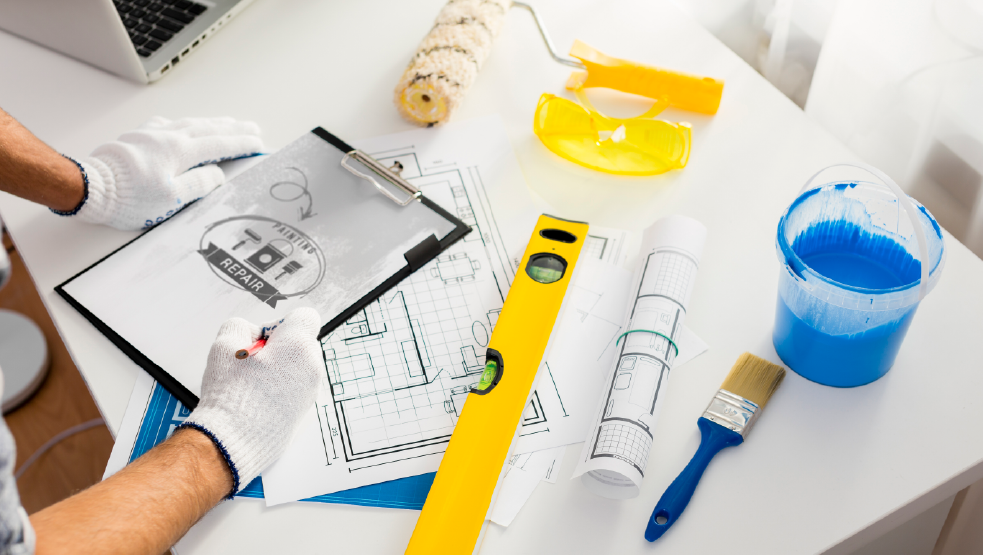Are you a professional painter? Are you running a painting business? You may have experienced situations where part way through you realized you didn’t have a required tool. You are not alone. This is a common occurrence in all service businesses—not just yours. If you have ever thought about what is least significant or most wanted in your painter’s toolbox, then we’ve got you covered.
This article lets you check what tools must be in your painter’s toolbox. You can also verify whether you may have missed something, which makes your painter’s life easy. Read on the 21 most essential tools your painters need and help achieve the best results.
21 Must-Have Painting Tools for Professional Painters
Paint Brushes
The painters should use a high-quality brush to ensure they’re getting the most out of their time and effort. Natural bristles, blended hairs with polyester backbone (the best type) can provide great results. Their ability to mimic traditional media like oils or acrylics in terms of not only consistency but also durability makes them perfect for outdoor work where weather conditions may change quickly without warning!
Paint Rollers
Paint rollers can help apply the paint evenly and quickly. Choose the right nap because it may affect the quality of application. A roller cover with a 3/4″ nap will hold more paint and get into the crevices of a rough surface better than one with a 1/4″ nap over stucco, which will rip apart quickly and not get paint into all the crevices.
The larger roller with 9” roller frames will be suitable for walls and ceilings, and a small 4” roller frame is ideal for doors, furniture, and cabinets.
Paint Sprayers
Paint sprayers can be a great way to apply the paint evenly and quickly. It can be used to cover single objects, walls, or entire rooms with your choice of paint. Unlike brushes or rollers, paint sprays offer uniform coverage, and there would be no marks from the painting process itself.
There are four types of paint sprayers available. An airless paint sprayer is the most suitable and commonly used among painting technicians. Other than that, compressed air or pneumatic paint sprayers can be used.
Tape Measure
A tape measure is an essential tool a painter can have. It helps to measure the painting areas accurately before painting. Without measuring and calculating the area, your painting technicians cannot determine how much paint they need to finish their job. Using a tape measure is not limited; it helps a painter accurately measure and cut pieces of tape to the correct size. There are a variety of tape measures available. Choose the suitable one based on the application.
Ladders and Scaffolds
Among various ladders, platform ladders are ideal and widely used for painting projects. It has many advantages, such as a large workspace holding the painter and their tools to complete a task. You can also prefer the A-frame ladders, which give great comfort while standing for long periods.
Frame scaffolds, also known as two scaffolding frames, are most advantageous when painting on uneven surfaces. Frames come in various widths ranging from 2′ wide to 5′ width. They are robust and stackable and have a lot of accessories that can be attached to them for more efficiency.
Drop Cloths
Even experienced painters cannot avoid paint spills. Drop cloths are large sheets of fabric made up of canvas or plastic that cover surfaces from paint drips and spills. are an essential part of any painter’s toolkit, as they can help protect surfaces from paint splatters, drips, and spills. Compared to plastic drop cloths, rubber-coated canvas drop cloths are the ones chosen by professional painters to avoid slippery and sustainability.
Sandpaper and Sanding Sponges
As a preparation task for walls, sandpaper can be used to sand down surfaces which help to get an even look after painting. It is responsible for gripping the surface and preventing the wall from peeling. 180 – 220 grit is preferred for the sanding finish for sanding between paint coats and is also great for distressing.
Sanding sponges are used for smoothening the texture of the surfaces. It comes with three different grits, 100, 150, and 220, and it can be used based on the application.
Wall Cleaning Agents
Wall cleaning is an inevitable task to get smooth and ensure good paint bonding. It should be carried out to clean the surface’s dust, grease, and stains. A simple sponge dipped in warm water can be used to clean the wall. For tough stains, TSP powder works well. Always ensure your painting technicians carry mild detergents, TSP, and cleaning sponges in their toolboxes.
Putty Knife
A putty knife can be used for cutting and filling the cracks in surfaces before painting them surface. It is also used to scrap off excess filler to even out the repaired surface. A set of two-inch putty knives and a six-inch-wide taping knife would be efficient with flexible blades.
Paint Thinner
Paint thinners are solvents that help to thin paint or remove paint from brushes, rollers, and other painting tools once the project is completed. Painting technicians commonly use solvents are acetone, turpentine, naphtha, toluene, and xylene. Choose the right paint thinner according to the material.
Painter’s Hard Hats
Painters’ hard hats are essential to protect the painter’s head, especially when working at heights. It will protect them if an object falls while working on risky construction site projects or commercial projects. Not all time; painters need hard hats. Basic painter’s hats can be used for low risked painting jobs, which can help keep paint out of their face and hair from paint.
Respirator Mask
It is always a good idea to wear a respirator mask while your painters tend to work with oil-based paints or other toxic chemicals. Whether it is sanding or brushing, it is necessary to wear a dust mask or respirator to protect your painters from harmful fumes.
Safety Glasses
Safety glasses will be good protective eyewear while painting and using paint thinners or paint. It is necessary to wear them when painting above the head level as well as sanding.
First Aid Kit
Painting tasks are greatly involved risks and hazards that may happen anytime. Working at heights is riskier. Your painter could slip, trip or fall while painting. Such situations are unavoidable in painting projects, yet safety control measures are necessary. In such high-risk environments, first aid kits must be tailored to your company’s hazards. They are vital to treating injured ones in the first place. Always ensure they have first aid kits in the toolbox.
Roller Trays
Roller trays make it easier to hold the paint, which lets the painters dip the roller and apply it on the surface quickly. It is available in hard plastic, but you do not need that all time. Use disposable plastic roller trays each time when you paint. Otherwise, use durable plastic roller trays by covering them with bin covers.
Paint Can Opener
Paint cans get stuck most time and may need extra leverage. A paint can opener is a tool designed to open cans of paint easily that are sealed shut. A strong handle and bottle opener end are the things you need to consider while buying.
Paint Stirrer/Stir Sticks
Stirring the paint before the application is unavoidable since the oil in the paint may come out while it is in the can. For stirring, stir sticks or paint stirrers are excellent tools to invest in when you deal with gallons of paint to mix different colors together.
Cordless Drill
A cordless drill becomes unavoidable in painting and home improvement projects. Before attaching hooks or other hardware to drill holes into walls, ensure your painters carry the right powered cordless drill in their toolbox.
Extension Poles
An extension pole on a paint roller allows you to paint ceilings and tall walls without constantly using a ladder or stretching. In addition to being unsafe, painting without paint roller extension poles can also be very tiring because your painters have to reach above their heads every time they paint at heights. They are a handy and very valuable ones to have in the toolbox.
Power/Pressure Washer (Optional)
The adhesion of paint on the walls can be improved, especially when your painters work with commercial projects, by washing the exteriors. Using a pressure washer, you can remove dust, dirt, chipping paint, grease, and oil from walls.
Heat Gun (Optional)
Heat guns make the painter’s job easy by scrapping the paint. It has a heating element inside and blows air to dry the paint, crack, and peel them off. Holding it in one hand and holding the paint scraper in the other allows for quick removal of paint.
Conclusion
With the right tools, painters can do their work faster and more efficiently. Painting technicians should invest in a variety of productivity-boosting devices to increase efficiency for maximum output!






